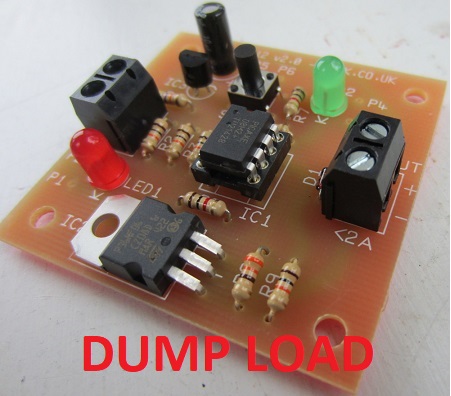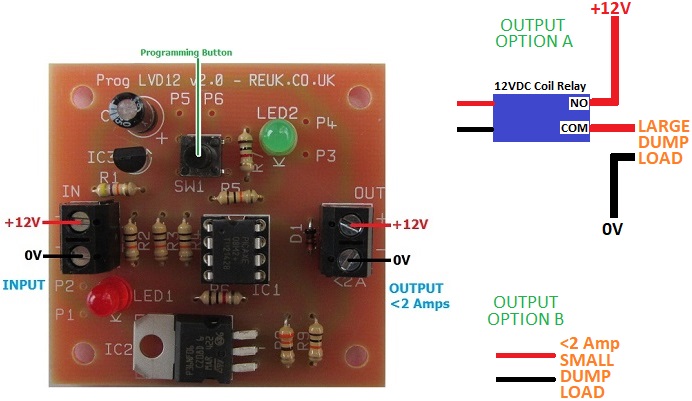
Additional Information
A dump load (also called a diversion load) is a device which will automatically connect power to a load or loads only when the measured voltage of the connected battery exceeds a certain level.
A dump load can be used as a basic charge controller to prevent a battery from being overcharged. It can also be used to limit when power hungry loads should be powered – for example, only powering a heater if the battery is well charged.
Dump loads are particularly useful in renewable applications such as solar and wind charging. With solar photovoltaics, when the battery is full, a typical solar charge controller will prevent further charging and so any subsequent solar generation is not exploited.
With a wind turbine it is essential that there is a load on the turbine at all times when it is operating whether that load be battery charging, powering a heater, or any other reliable load. If the turbine is not loaded, it will spin too quickly in high winds and could be damaged. We do not recommend using this dump load device for wind turbines. Click here for more sophisticated wind turbine charge controllers.
This dump load is designed for use with 12V battery systems. The output is rated at up to 2 Amps, and can be connected to your choice of suitably rated relay to switch the power to your loads (or to directly power up to around 20 Watts of 12VDC loads directly). When the battery voltage is measured to be above a user-set high value continuously for 10 seconds, the dump load output will turn on. Then, when the battery voltage is measured to have fallen below a user-set low value continuously for 10 seconds, the dump load will turn off.
Programming the Dump Load
Connect your dump load controller as shown in the image above with the output connected to a relay (option A) or directly to a small (<2A) load (option B).
There are two voltages which must be programmed into the controller – the dump voltage above which you would like the dump load to engage, and the cancellation voltage below which you would like the dump load to be cancelled.
We have selected the following base values to act as the starting point for use when programming the voltage thresholds:
Base dump voltage – 12.0V
Base cancellation voltage – 13.5V
These values have been chosen since it is unlikely that you would ever need the dump voltage to be as low as 12.0V, and similarly unlikely that you would need the cancellation voltage to be as high as 13.5V for a 12V battery system.
To programme the controller, the user needs to enter the number of 0.1V steps above or below these base values respectively to set their desired dump voltage and cancellation voltage.
Start Programming
Press the programming button once. The red and green LEDs will turn on and will remain on for two seconds. When they turn off, press the button X times where X is the number of 0.1V steps above the base dump voltage that will give your desired dump voltage. For example, if you would like to turn on your dump load at above 13.2V, you would need to press the button 12 times since the base dump voltage (12.0V) plus 12*0.1V gives the desired 13.2V. See the table below:
Relationship between number of button presses and the Dump Voltage
Five seconds after the button was last pressed, the red and green LEDs will turn on again for two seconds. When they turn off, press the button Y times, where Y is the number of 0.1V steps below the base cancellation voltage that will give you your desired cancellation voltage. For example, if you would like the dump load to switch off at below 12.7V, you would need to press the button 8 times since the base cancellation voltage (13.5V) minus 8*0.1V gives the desired 12.7V. See the table below:
Relationship between number of button presses and the Cancellation Voltage
Five seconds after the button was last pressed, the green LED will flash X times and then the red LED will flash Y times to give visual confirmation of successful programming. That is the controller programmed, and it will now start standard operation.
notes:
The values of X and Y are stored in memory and are NOT lost when the controller is disconnected from the battery even for an extended period of time. Therefore, you only need to re-programme the controller if you would like to change one or both of the voltage thresholds.
The dump voltage must be set to at least 0.3V higher than the cancellation voltage. If your programming fails to meet this condition, then the controller will automatically set the cancellation voltage to be 0.3V below the disconnect voltage. The red and green LEDs will alternately flicker for a few seconds to give you a visual warning that this has happened and to remind you to re-programme the controller with more suitable values.
Using the Dump Load Controller
When the controller is first connected to the battery, if the battery voltage is measured to be higher than the dump voltage, the dump load output will immediately turn on. Subsequently, if the measured voltage falls below the cancellation voltage, the red LED will turn on. If the voltage continues to remain below the cancellation voltage continuously for 10 seconds, the dump load output and the red LED will turn off.
Now the controller will be waiting for the voltage to rise. (The following is also what happens when you first connect the controller to a battery that is not above the dump voltage.) When the voltage climbs over the dump voltage, the green LED will turn on. If the voltage remains above the dump voltage continuously for 10 seconds, the dump load output will turn on and the green LED will turn off.
Now the controller will revert to waiting for the voltage to fall…and continue this repeating cycle.
Specifications
This dump load controller can be powered with anything from 9 to 16VDC, more than adequate to cope with any 12V battery application. The power consumption of the device itself is a few milliAmps when an LED is illuminated, and less the rest of the time. This is negligible in comparison with the power consumption of the relay you will connect to the controller output and of course to the dump load itself.
This dump load controller is hand-calibrated to be accurate to within +/- 0.1V.
Question and Special Requests
If you have any questions about this controller, please email neil@reuk.co.uk. Similarly, if this dump load controller is not quite what you are looking for, email neil@reuk.co.uk with details of your particular requirements and we should be able to make you something suitable.
